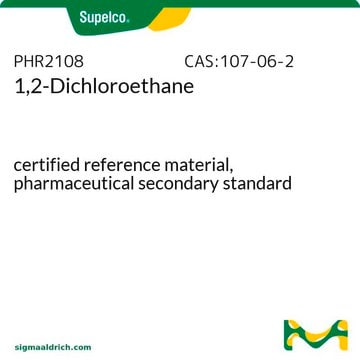319929
1,2-Dichloroethane
ACS reagent, ≥99.0%
Synonim(y):
Ethylene chloride, Ethylene dichloride
About This Item
Polecane produkty
klasa czystości
ACS reagent
Poziom jakości
gęstość pary
3.4 (20 °C, vs air)
ciśnienie pary
87 mmHg ( 25 °C)
Próba
≥99.0%
Postać
liquid
temp. samozapłonu
775 °F
granice wybuchowości
15.6 %
zanieczyszczenia
≤0.0003 meq/g Titr. acid
≤0.03% water
pozostałość po odparowaniu
≤0.002%
kolor
APHA: ≤10
clear
współczynnik refrakcji
n20/D 1.444 (lit.)
tw
83 °C (lit.)
mp
−35 °C (lit.)
gęstość
1.256 g/mL at 25 °C (lit.)
ciąg SMILES
ClCCCl
InChI
1S/C2H4Cl2/c3-1-2-4/h1-2H2
Klucz InChI
WSLDOOZREJYCGB-UHFFFAOYSA-N
Szukasz podobnych produktów? Odwiedź Przewodnik dotyczący porównywania produktów
Opis ogólny
Zastosowanie
- As electron acceptor in the culture medium of Dehalococcoides ethenogenes 195.
- As model compound for chlorinated organics in various studies.
- Chemical doping during the fabrication of Cl-doped few-layer WS2 or MoS2 back gate field-effect transistors (FETs).
Hasło ostrzegawcze
Danger
Zwroty wskazujące rodzaj zagrożenia
Zwroty wskazujące środki ostrożności
Klasyfikacja zagrożeń
Acute Tox. 3 Inhalation - Acute Tox. 4 Oral - Asp. Tox. 1 - Carc. 1B - Eye Irrit. 2 - Flam. Liq. 2 - Skin Irrit. 2 - STOT SE 3
Organy docelowe
Respiratory system
Kod klasy składowania
3 - Flammable liquids
Klasa zagrożenia wodnego (WGK)
WGK 3
Temperatura zapłonu (°F)
55.4 °F - closed cup
Temperatura zapłonu (°C)
13 °C - closed cup
Wykazy regulacyjne
Wykazy regulacyjne dotyczą głównie produktów chemicznych. Można w nich podawać ograniczoną liczbę informacji na temat produktów niechemicznych. Brak wpisu oznacza, że żaden ze składników nie znajduje się w wykazie. Użytkownik odpowiada za zagwarantowanie bezpiecznego i zgodnego z prawem stosowania produktu.
EU REACH SVHC Candidate List
EU REACH Annex XVII (Restriction List)
EU REACH Annex XIV (Authorisation List)
Certyfikaty analizy (CoA)
Poszukaj Certyfikaty analizy (CoA), wpisując numer partii/serii produktów. Numery serii i partii można znaleźć na etykiecie produktu po słowach „seria” lub „partia”.
Masz już ten produkt?
Dokumenty związane z niedawno zakupionymi produktami zostały zamieszczone w Bibliotece dokumentów.
Nasz zespół naukowców ma doświadczenie we wszystkich obszarach badań, w tym w naukach przyrodniczych, materiałoznawstwie, syntezie chemicznej, chromatografii, analityce i wielu innych dziedzinach.
Skontaktuj się z zespołem ds. pomocy technicznej









